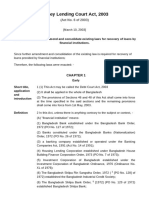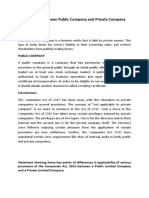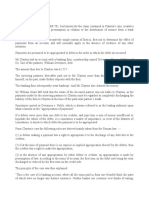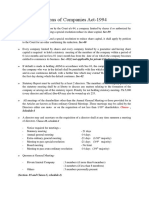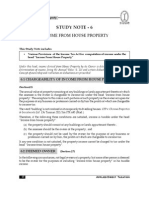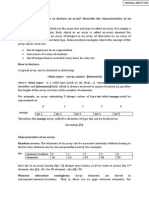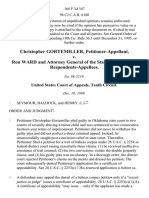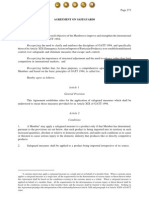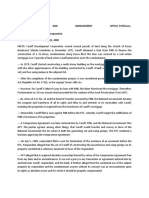Company Act, 1994-Fundamental Questions & Answers
Company Act, 1994-Fundamental Questions & Answers
Uploaded by
Nicholas ShantoCopyright:
Available Formats
Company Act, 1994-Fundamental Questions & Answers
Company Act, 1994-Fundamental Questions & Answers
Uploaded by
Nicholas ShantoOriginal Title
Copyright
Available Formats
Share this document
Did you find this document useful?
Is this content inappropriate?
Copyright:
Available Formats
Company Act, 1994-Fundamental Questions & Answers
Company Act, 1994-Fundamental Questions & Answers
Uploaded by
Nicholas ShantoCopyright:
Available Formats
Company
1. Define a company.
The term company is used to describe an association of a number of persons, formed for some
common purpose and registered according to the laws relating to companies. According to sec.2 (1-
c), Companies Act, 1994 Company means a company formed and registered under this Act or any
existing company.
2. Describe the characteristics of a company.
a. Law created concern: A company comes into existence only after registration under the
Companies Act, 1994. It is an artificial person recognized by the law.
b. Separate legal entity: A company is considered a separate legal entity, conducting business in its
own name. Therefore, corporations may own property, enter into binding contracts, borrow money,
sue and be sued and pay taxes.
c. Unlimited life: As a company is owned by stockholders and managed by employees, the sale of
stock, death of a stockholder, or inability of an employee to function does not impact the continuous
life of the corporation.
d. Number of shareholders: The number of shareholders of a company is set by the Companies
Act, 1994.For private limited company, the minimum and maximum number of shareholders is 2 and
50. For public limited company, the minimum number of shareholders is 7 and the maximum
number of shareholders is limited by the number of shares it offers.
e. Voluntary association: A company is an association of many persons on a voluntary basis.
Therefore a company is formed by the choice and consent of the members.
f. Separate management: Although a company is owned by the shareholders but it is managed by
the Board of Directors, Managing Director or Manager and/or Management Agent. These persons
are selected in the manner provided by the Act and the Articles of Association of a company.
g. Limited liability: The liability of stockholders is usually limited to the amount each has invested
in the company. Personal assets of stockholders are not available to creditors or lenders seeking
payment of amounts owed by the corporation.
h. Statutory obligations: A company is required to comply with various statutory obligations
regarding management such as filing balance sheets, creating and maintaining accounts and registers,
calling statutory meetings etc.
i. Common seal and residence: Due to separate legal entity, a company must have a common seal
which usage is mandatory to any written document. A company also has a registered office for
taxation and other purposes.
j. Transferability of stocks and shares: Particularly in a public company, the stock or share can be
easily transferred in part or total at the discretion of the shareholder. The shareholder wishing to
transfer (sell) stock does not require the approval of the other stockholders to sell the stock or share.
Privately held companies have some restrictions on the transfer of stock and shares.
k. Ease of capital acquisition: A company can obtain capital by selling stock or bonds. This gives a
company a larger pool of resources because it is not limited to the resources of a small number of
individuals.
l. Share capital: A company must have a share capital, otherwise it cannot work. Any person having
a sound mind can purchase the share of the company and become its shareholder.
3. Discuss the various forms of company.
There are mainly four types of company. They are-
a. Chartered Company: Chartered Company mainly evolved in the 16
th
century in the Europe;
created by a charter granted by King or Queen. It is regulated by a charter and the charter usually
conferred a trading monopoly upon the company in a specific geographic area. Company Act does
not act upon it. Example- East India Company.
b. Statutory Company: When a company is formed by passing a special act at the Legislature or at
the National Parliament of the country, it is called a statutory company. For example-Dhaka Electric
Supply Company (DESCO). These companies are formed mainly with an intention to provide public
services like gas, water, electricity or national security of the country.
c. Registered Company: Companies which are formed under the Companies Act, 1994 or were
registered under the previous Companies Act therein consolidated and recognized are called
registered companies. There are two types of registered companies-
1. Private Company: A Private Company is one which, by its articles-restricts the rights of the
members to transfer their shares, if any; limits the number of its members (not containing its
employees) to 50; prohibits invitation to the public to subscribe for any shares in or debentures of the
company.- Sec. 3(1-iii)
2. Public Company: "public company" means a company incorporated under this Act or under any
law at any time in force before the commencement of this Act and which is not a private company-
Sec. 3(1-iv). Public Companies might be classified into three types-
Company limited by shares: A company limited by shares is called a Public Limited
Company. Here the persons financial liability is limited to a fixed sum, most commonly the
value of his share in the company. A shareholder in this case, is not personally liable for any
of the debts of the company, other than for the value of his share in that company.
Company limited by guarantee: A company limited by guarantee is called a Guarantee
Company, with its capital limited by guarantee so that each member undertakes to be liable to
pay the debts of the company up to a certain amount in case of winding up. Clubs, Trade
Associations and Societies, promoting social objectives are examples of this type.
Unlimited Company: In a company where the liability of its shareholders is unlimited, as in
partnership a firm is called an Unlimited Company. Such companies are permitted under the
Company Act but are not known.
d. Other forms of company: There are some other types of company. They are-
1. Holding Company: A Holding Company is a parent company that owns enough voting stock in
another company to control its board of directors and therefore controls its policies and management.
2. Subsidiary Company: A Subsidiary Company is a company that is partly or completely owned
by another company (holding company) that holds a controlling interest in the subsidiary company.
Sec. 4 explains holding company and subsidiary company.
3. Government company: A Government Company is one in which not less than 51% of the paid
up share capital is held by the Central Government and/or any State Government or Governments or
by any two or more than together. The Subsidiary of such a company is also a Government
Company.
4. Foreign Company: A foreign company is a term used for an existing company that is registered
to do business in a state or other jurisdiction other than where it was originally incorporated.
4. Discuss the formation of a company.
According to Company Act, 1994- to form a company whether it is Public or Private, a systematic
criteria must be followed:
1. Promotional Stage: In this stage, at least 2 promoters for Private Company and 7 promoters for
the Public Company need to complete these primary tasks:
a. Decision making: Firstly, promoters need to identify their business sector, study its
feasibility, prepare an efficient project according to their sector and prepare financial plan for
the project. Secondly, they need to make decision about the amount of share capital, price of
each share, amount of minimum capital, directors, qualification shares of directors etc.
b. Name clearance: Promoters then set up an appropriate name for their company. No existing
name can be used. They submit their desired name or names to the Office of the Registrar of
Joint Stock Companies and Firms with registration fee. Registrar then approves the name and
provides them name clearance certificate and asks them to provide more documents for the
next process.
2. Document Preparation Stage: In this stage, the promoters submit the most two important
documents of the company. They are:
a. Memorandum of Association: Main document of the company. In this document- Company
name, address, objectives, consents, share capital, liabilities etc. are described in details.
b. Articles of Association: Rules and regulations for the internal management of the company
are described in details in this document. Promoters can use schedule-1 according to the
Company Act, 1994 instead of Articles of Association. If they do so, no separate document
needs to be formed and submitted.
3. Certificate of Incorporation Collection Stage: In this stage, promoters fill up important forms
and submit them to the Registrar office with necessary documents and stamp duty and fee. Promoters
must submit-
a. 3 copies of the Memorandum of Association.
b. 3 copies of the Articles of Association. A statutory declaration of statement if schedule-1
is used instead of Articles of Association
c. A list of persons who have consented to be directors of the company, their address and
professions
d. A written consent duly signed to act as directors
e. An undertaking in writing signed by each director to take and pay for their qualification
shares, if any.
f. A statutory declaration by an attorney or a chartered accountant or by a director or by any
senior officer engaged in formation of company that all requirements of the Act and Rules
there under in respect of the registration have been compiled with.
The Registrar verifies all the submitted documents and when he is satisfied, he provides Certificate
of Incorporation to the promoters. A Private Company can start its business after getting
Certificate of Incorporation but a Public Company must collect Certificate of Commencement.
4. Commencement Stage: This step is only for the Public companies. Here the promoters start to
arrange the share capital. They usually do this-
a. By creating prospectus and share them to the public to sell shares of the company.
b. By selling shares to the known people (friends or relatives) without sharing prospectus to the
public and thus collect share capital.
c. Collecting money from the qualification shares which the directors hold.
Then according to section 150(1), Company Act 1994, a director is required to submit the following
documents:
a. A statutory declaration that the minimum capital has been collected.
b. A statutory declaration that the directors have bought their qualification shares.
c. A copy of prospectus.
After successful submission, the promoters of Public Company get Certificate of Commencement
and start their business.
5. Describe the distinction between Private and Public companies.
Subject Private Company Public Company
1. Minimum
capital
Must have a minimum paid up capital
of R.S. 100000
Must have a minimum paid up capital
of R.S. 500000
2. number of
members
Number of members cannot be less
than two and more than 50
Number of members cannot be less
than seven and no maximum has been
fixed
3.Transferability
of shares
Its articles must restrict its members
the right of transfer their shares.
There is no restriction for the transfer
of shares.
4.Invitation to
public
Cannot invite public to purchase its
shares or debentures.
Can invite public to purchase its
shares and debentures
5.Number of
directors
Must have at least 2 directors Must have at least 3 directors
6. Statutory
meeting
Need not to hold the statutory meeting
or file the statutory report
Need to hold the statutory meeting or
file with the Register a statutory report
7. Name Must use words Private Limited at
the end of its name
Only need to mention Limited at the
end of its name
8.Commencement Can commence its business as soon as
it is incorporated.
Cannot commence its business
immediately unless it has been
granted Certificate of
Commencement of business.
9. Prospectus Does not need a Prospectus Must need a prospectus or a statement
in lieu of prospectus to sell its shares
to the public
10.Share
warrants
Cannot issue share warrants against its
fully paid shares
Can issue share warrants against its
fully paid shares
11. Consent of the
directors
There is no need to give the consent
by the directors of a Private Company.
The directors of the Public Company
must have file with Registrar consent
to act as the Director of the company.
12. Qualification
shares
The Directors need not sign an
undertaking to acquire qualification
shares
The Directors are required to sign an
undertaking to acquire qualification
shares
13. Quorum The quorum for a Private Company is
two members present personally.
For a Public Company, five members
must be present personally to
constitute quorum.
14. Managerial
remuneration
No restriction on managerial
remuneration.
Total managerial remuneration for A
Public Company cannot exceed 11%
of the net profits.
6. Discuss the Legal positions of Directors.
There are different views about the legal positions of the directors. But the directors might work in
these positions-
a. Director as Trustee: A director is not a trustee in the correct legal sense of term. A trustee is a
person who is the owner of the property and deals with it as principal. A director is not the owner of
the company and he does not enter into contracts with third parties as owner of the companys
property. But the directors position is similar to that of a trustee because he is bound to exercise his
power in the interest of the company and is liable for the misuse of his powers.
b. Director as Employee: Being a director does not make that person an employee of the company.
If the company enters into a service contract with the director, then the director becomes an
employee. For example, a director may be the legal advisor of a company. In this circumstance,
relevant aspects of employment law apply in addition to the law relating to directors.
c. Director as Agent: It is more accurate to describe directors as agents of the company. The
directors are agents of the company because the company acts through the directors. Contracts with
third parties are entered into by the directors, not as principals but as agents of the company. An
agent is bound to take instructions from his principal. But by the articles and under the Companies
Act, 1994, the directors have independent power in certain matter. Even the directors are not bound
to consult the shareholders in all matters.
d. Director as Officer: Directors are treated as officers of the company. An officer, who is in
default may be punished if he is guilty of default, no compliance, failure or refusal of the rules
regarding the Companies Act,1994.
7. Discuss the appointment methods of the Directors.
A Director of a company may be appointed by various ways. These ways are described in brief-
a. By promoters: According to sec-91(a), the subscriber of the memorandum shall be deemed to be
the directors of the company until the first directs are appointed in the Annual General
Meeting(AGM) of the company. They are primarily elected by the promoters of the company and
may work as directors until the AGM.
b. By shareholders: According to sec-91(b), the directors of the company are elected by the direct
votes of the shareholders of the company in the AGM. This the general rule for appointing directors.
c. By board of directors: According to sec-91(c), the Board of Directors can appoint directors of the
company under following conditions-
The Board of Directors can appoint directors for any temporary vacancy in the post of
directors.
By the articles mentioned in the Memorandum of the company or by the decisions made in
the AGM by the shareholders, the Board of Directors may appoint a person for the absence of
other director.
By the articles mentioned in the Memorandum of the company. The Board of Directors might
appoint additional directors for the company if necessary.
d. by managing agent: Sec-125 of the Companies Act,1994 provides power to the managing agent
of the company to appoint directors. But it shall not exceed in number one-third of the total number
of directors.
e. by third parties: The article under certain circumstances may give power to the debenture holders
of the creditors or the investors of the company to appoint their nominee to the Board of Directors.
f. by government: By the articles mentioned in the Memorandum of the company or by the
application of the shareholders, the government may appoint directors of the company anytime.
8. Discuss the Dissolution process of the company.
Dissolution is the last stage of liquidation, the process by which a company or part-of-a company is
brought to an end, its legal entity is terminated, and the assets and property of the company
redistributed.
According the Sec. 234, Companies Act, 1994, there are three fundamental ways of dissolution of
the company. They are described in brief-
a. Compulsory winding up by the court: A company may be wound up by the Court by the
application of shareholders and/or creditors, investors and/or the Chief Registrar in following cases:
1. If company has by special resolution resolved that the company be wound up by the Court.
2. If Default is made in filing the statutory report or in holding the statutory meeting.
3. If the company does not commence its business or fails to commence its business or suspends
its business within a year from its incorporation.
4. If the minimum number of members is reduced.
5. If the company is unable to pay the debts.
6. If the Court is of opinion that it is just and equitable that the company should be wound up.
b. Voluntary Dissolution: If the shareholders or the directors of the company, voluntarily want an
end to company, it is called voluntary dissolution. It may occur in following two ways:
1. Voluntary Dissolution of members: A company which has the ability to pay its debts can
come to an end after the official declaration of the Board of Directors if-
The companys business life is fixed in the Memorandum of the company and it
expires.
There is article mentioned in the Memorandum of the company that the company will
come to an end after fulfilling its objective and that objective is fulfilled.
There is article mentioned in the Memorandum of the company that the company will
come to an end after experiencing a special event and that event is faced.
2. Voluntary Dissolution of creditors. A company unable to pay its debts can come to an end
after the official declaration of the Board of Directors under the supervision of creditors.
c. Under supervision of court: A company may come to an end under the supervision of Court in
following cases:
1. If Court comes to an opinion that the company is being terminated to defraud its
shareholders.
2. If Court finds out defects in the dissolution process.
3. If Court finds out disorder and bias in assets and property redistribution process.
4. If the Court is of opinion that it is just and equitable that the company should be wound up
under the supervision of Court.
9. Discuss the power of the directors.
A company's directors act on behalf of the company. They only have powers to do what the company
itself is legally entitled to do. The powers that directors have are those which have been conferred
upon them by the company, usually via the company's Articles of Association. Normally, the powers
of the Directors are formally exercised by a resolution at a board meeting, usually decided by a
majority of votes.
Typical duties of boards of directors include:
1. Taking decisions of companys management
2. Share issues and allotment of shares
3. Calling for money from the shareholders
4. Debentures issue and taking decisions for borrowing money from external sources.
5. Forfeiture of shares
6. Maintenance of companys accounts
7. Appointment of managing agents or directors
8. Selecting, appointing, supporting and reviewing the performance of the chief executive
9. Calling for AGM and other meetings
10. Monitoring the financial reporting of the company
11. Approval of dividends for shareholders
12. Transferring retained earnings to reserve funds
13. Making contracts on behalf of the company
14. Making decisions about investment in other company or projects
15. Corporate governance
16. Setting the salaries and compensation of company management
17. Approving annual budget
18. Dissolution of the company
10. Discuss the disqualification of directors.
By virtue of Sec.-92: A person shall not be capable of being appointed as director of a company by
the articles unless he/she-
1. Signed and filed with the Registrar a consent in writing to act as such director; and
2. In the case of companies having a share capital -
a. Signed the memorandum for a number of shares not less than his qualification shares; or
b. Taken from the company and paid or agreed to pay for his qualification shares; or
c. Signed and filed with the registrar a contract in writing to take from the company and pay for
his qualification shares; or
d. Made and filed with the Registrar any affidavit to the effect that a number of shares not less
than his qualification shares are registered in his name.
2. By virtue of Sec. 94- A person shall not be capable of being appointed director of a company, if
a. He has been found to be of unsound mind by a competent court and the finding is in force; or
b. He is an undercharged insolvent; or
c. He has applied to be adjudicated as an insolvent and his application is pending; or
d. He has not paid any call in respect of shares of the company held by him, whether alone or
jointly with others, and six months have elapsed from the last day fixed for the payment of
the call; or
e. He is a minor.
11. Discuss the removal of Directors.
a. Removal by decision: according to Sec. 106(1), The company may be extraordinary resolution
remove any share-holder director before the expiration of his period of office and may by ordinary
resolution appoint another person in his stead and the person so appointed shall be subject to
retirement at the same time as if he had become a director on the day on which the director in whose
place he is appointed was last elected director.
b. removal by law: According to Sec. 108(1), The office of a director shall be vacant, if-
1. He fails to obtain within the time specified in section 97 (1) or at any time thereafter ceases to
hold, the qualification shares, if any, necessary for his appointment; or
2. He is found to be of unsound mind by a competent court; or
3. He is adjudged an insolvent; or
4. He fails to pay calls made on him in respect of shares held by him within six months from the
date of such calls being made; or
5. He or any firm of which he is a partner or any private company of which he is a director,
without the sanction of the company in general meeting accepts or holds any office of profit
under the company other than that of a managing director or manager or a legal or technical
adviser or a banker; or
6. He absents himself from three consecutive meeting of the directors or from all meetings of
the directors for a continuous period of three months, whichever is the longer, without leave
of absent from the Board of Directors; or
7. He or any firm of which he is a partner or any private company of which he is a director
accepts a loan or guarantee from the company in contravention of section 103; or
8. He acts in contravention of section 105.
12. What is Memorandum of Association? Discuss its contents.
The Memorandum of Association, often simply called the Memorandum is a document which
contains the fundamental rules regarding the constitution and activities of a company.
The Memorandum defines the power or extent of the actions of the company. It lays down the object
of the company and the company cannot surpass the objects even if each associate concurs. Thus, a
company cannot lawfully do any take action which is not sanctioned by its memorandum of
association. It is the heart and soul of a company.
Clause/Contents: According to Sec. 6, Companies Act, 1994, the Memorandum contains the
following clauses:
1. Name clause: the name of the company, with "limited" as the last word in its name in case of
Public Limited Company.
2. Address Clause: the address of the registered office of the company. The work area of the
company is also described here.
3. Objective clause: the most important clause- the objects of the company, and, except in the
case of trading companies, the territories to which they extend.
4. Liability clause: the liability of the members of the company- liability of the members is
limited in case of Public Limited and liability is unlimited in case of Unlimited Company.
5. Capital Clause: the amount of share capital with which the company proposes to be
registered; types of shares and total number of shares; price of each share in respect of its
type.
6. Consent Clause: The promoters of the company shall sign the following things in front of at
least one witness-
a. that they shall form the company according to the articles of the Memorandum
b. that they shall buy the number of shares written opposite to their names
13. What is Articles of Association? Discuss its contents.
The Articles of Association is a document which contains rules, regulations and bye-laws regarding
the internal management of the company.
Articles of association often identify the manner in which a company will issue stock shares, pay
dividends and audit financial records and power of voting rights. This set of rules can be considered
a user's manual for the company because they outline the methodology for accomplishing the day-to-
day tasks that must be completed.
The contents of the Articles of Association are:
1. rules regarding daily operations of the company
2. rules regarding directors-
Appointments, powers, responsibilities, removal, qualification, disqualification
3. rules regarding executives and employees-
Appointments, wages, remuneration, removal
4. rules regarding shareholders-
Powers, rights and responsibilities, relations
5. rules regarding share capital-
Total amount, classification, alteration
6. rules regarding shares-
Total number, total amount, types, price, transferability, calling, forfeiture
7. rules regarding meeting-
AGM, calling of meeting, voting methods, quorum
8. rules regarding book keeping, accounts and audits
9. rules regarding stakeholders-
Appointment process of managing agent, name and address of bankers, auditors, brokers etc.
10. rules regarding dividends and reserves
11. rules regarding borrowing and investment methods
12. rules regarding usage of Common Seal
13. rules regarding secrecy and indemnity
14. rules regarding winding up-
Methods, property and assets redistribution process
You might also like
- Money Loan Court Act 2003-FinalDocument9 pagesMoney Loan Court Act 2003-FinalKazi Azad75% (8)
- Kranium Sky 1Document22 pagesKranium Sky 1joan mukuhaNo ratings yet
- Assignment On: Banking Companies Act, 1991Document11 pagesAssignment On: Banking Companies Act, 1991Mehedi Hasan100% (4)
- Hire Purchase QuestionsDocument3 pagesHire Purchase QuestionsDiana MintoNo ratings yet
- Promoters: Farzana Yeasmin MehanazDocument14 pagesPromoters: Farzana Yeasmin MehanazManjare Hassin RaadNo ratings yet
- Meaning of A Corporate Veil: Statutory Provisions For Lifting The VeilDocument2 pagesMeaning of A Corporate Veil: Statutory Provisions For Lifting The VeilHossainmoajjemNo ratings yet
- Company Law - Assignment by Simon (BUBT)Document22 pagesCompany Law - Assignment by Simon (BUBT)Simon Haque67% (3)
- Companies Act 1994Document34 pagesCompanies Act 1994msuddin7688% (26)
- Money Loan Court ActDocument26 pagesMoney Loan Court ActTasnim Arnika50% (2)
- Security Law Practical QuestionsDocument18 pagesSecurity Law Practical QuestionsIsha YadavNo ratings yet
- Partnership Act 1932-Questions & Answers (BL)Document13 pagesPartnership Act 1932-Questions & Answers (BL)Erfan Khan100% (1)
- Money Lending Court Act 2003Document29 pagesMoney Lending Court Act 2003gehapi3428No ratings yet
- Set Off and Carry Forward of Losses, Indian Income TaxDocument4 pagesSet Off and Carry Forward of Losses, Indian Income TaxAbhishek Sharma100% (1)
- Q2. What Is Meant by Implied Authority of A Partner? Are Third Parties Affected by Restrictions Placed On Such Implied Authority?Document2 pagesQ2. What Is Meant by Implied Authority of A Partner? Are Third Parties Affected by Restrictions Placed On Such Implied Authority?Jay Patel100% (2)
- Essentials of Company Meetings: A. Statutory MeetingDocument5 pagesEssentials of Company Meetings: A. Statutory MeetingHaji HalviNo ratings yet
- Differentiate Between Public Company and Private CompanyDocument7 pagesDifferentiate Between Public Company and Private CompanymayankNo ratings yet
- Opening Accounts of Various Types of CustomersDocument26 pagesOpening Accounts of Various Types of CustomersnayanPatel4677No ratings yet
- Artha Rin Adalat Ain - 2003 (With Latest Amendment) The Limitation Act - 1908Document19 pagesArtha Rin Adalat Ain - 2003 (With Latest Amendment) The Limitation Act - 1908MD RakibulNo ratings yet
- Notes On Arthorin Adalat Ain 2003Document10 pagesNotes On Arthorin Adalat Ain 2003Rabiul AualNo ratings yet
- Winding Up of CompaniesDocument23 pagesWinding Up of CompaniesAkash GoyalNo ratings yet
- CLAYTON'S CASE & RulesDocument3 pagesCLAYTON'S CASE & Rulesvivekananda RoyNo ratings yet
- Law Sale of Goods Act 1930 (Unit 3,4) Sugg TapDocument4 pagesLaw Sale of Goods Act 1930 (Unit 3,4) Sugg Tapshubhamsavji13100% (1)
- Special Type of CustomersDocument2 pagesSpecial Type of Customers122087041 YOGESHWAR D0% (1)
- 5 6323318773231124699 PDFDocument35 pages5 6323318773231124699 PDFJayant Mittal100% (2)
- Very Short Answer Type Questions:: Unit-4 Chapter-3: Winding-Up of CompaniesDocument32 pagesVery Short Answer Type Questions:: Unit-4 Chapter-3: Winding-Up of CompaniesAanu GappaNo ratings yet
- Borrowing Powers (Debentures and Charges) : Dr. Bharat G. KauraniDocument25 pagesBorrowing Powers (Debentures and Charges) : Dr. Bharat G. Kauranishubham kumar0% (1)
- Erlanger V New Sombrero Phosphate CompanyDocument4 pagesErlanger V New Sombrero Phosphate CompanyAsare William50% (2)
- Special Contract ActDocument26 pagesSpecial Contract Actanusaya1988100% (1)
- Bankruptcy Act BangladeshDocument16 pagesBankruptcy Act BangladeshMarjia Heemi57% (7)
- Capital Markets - Practical Problems: Green Shoe OptionDocument9 pagesCapital Markets - Practical Problems: Green Shoe OptionGautamSinghNo ratings yet
- Liquidators - Role, Powers and ResponsibiltiesDocument3 pagesLiquidators - Role, Powers and ResponsibiltiessimuleguminternshipsNo ratings yet
- Corporate Accounting Theory For First Unit-2Document9 pagesCorporate Accounting Theory For First Unit-2Rigved PrasadNo ratings yet
- Underwriting Commision 1Document9 pagesUnderwriting Commision 1AjithkumarNo ratings yet
- Borrowing Powers of A CompanyDocument5 pagesBorrowing Powers of A CompanyimadNo ratings yet
- The Securities Contracts (Regulation) Act, 1956Document10 pagesThe Securities Contracts (Regulation) Act, 1956Akshay Aggarwal100% (1)
- Banking Companies Act 1991 Final PDFDocument5 pagesBanking Companies Act 1991 Final PDFCryptic LollNo ratings yet
- Bank Company Act, 1991Document57 pagesBank Company Act, 1991Akhter Uj Jaman GalibNo ratings yet
- Insurance Claims For Loss of Stock and Loss of Profit 2 PDFDocument22 pagesInsurance Claims For Loss of Stock and Loss of Profit 2 PDFEswari Gk100% (1)
- "Finder of Lost Goods" in LAW OF CONTRACTSDocument21 pages"Finder of Lost Goods" in LAW OF CONTRACTSSai Sreenadh100% (1)
- Income From House PropertyDocument24 pagesIncome From House PropertyIMRAN ALAMNo ratings yet
- 1.definition of A Company and Its CharecteriosticsDocument11 pages1.definition of A Company and Its Charecteriosticssunitmishra2007No ratings yet
- Alteration of Share CapitalDocument20 pagesAlteration of Share Capitalmohitag72100% (2)
- Important Sections of Companies Act-1994:, Schedule-IDocument12 pagesImportant Sections of Companies Act-1994:, Schedule-IBabu babu100% (2)
- Power, Function and Duties of Directors andDocument20 pagesPower, Function and Duties of Directors andHimanshu JainNo ratings yet
- Garnishee OrderDocument15 pagesGarnishee OrderH B CHIRAG 1950311No ratings yet
- The Essential Elements of PartnershipDocument11 pagesThe Essential Elements of PartnershipEapsita Pahari100% (1)
- Arbitration Act 2001 PDFDocument11 pagesArbitration Act 2001 PDFCryptic LollNo ratings yet
- Income From House Property-6Document9 pagesIncome From House Property-6s4sahithNo ratings yet
- Insurance Act 2010 PDFDocument7 pagesInsurance Act 2010 PDFCryptic Loll100% (1)
- Labour Law in BangladeshDocument103 pagesLabour Law in BangladeshNazmul Hussain Nehal100% (1)
- Criminal Court Stracture of BangladeshDocument3 pagesCriminal Court Stracture of BangladeshLowlyLutfur100% (3)
- Question Papers of Banking and Negotiable Instrument ActDocument93 pagesQuestion Papers of Banking and Negotiable Instrument ActM NageshNo ratings yet
- Secrecy of Customers AccountsDocument10 pagesSecrecy of Customers Accountslittlemagicpk0% (2)
- Differences and Similarities Between Cheque, Bill of Exchange, Promissory NotesDocument2 pagesDifferences and Similarities Between Cheque, Bill of Exchange, Promissory NotesOmkar Padave100% (1)
- Remedies To Debenture HoldersDocument3 pagesRemedies To Debenture Holdersmrignangini2001No ratings yet
- Borrowing Power of Company PDFDocument12 pagesBorrowing Power of Company PDFmanishaamba7547No ratings yet
- Company Law: Nature of A CompanyDocument151 pagesCompany Law: Nature of A Companychangumangu100% (1)
- Assignment On CompanyDocument11 pagesAssignment On CompanyHossainmoajjemNo ratings yet
- Unit 3 - Companies Act 1. Define CompanyDocument17 pagesUnit 3 - Companies Act 1. Define CompanyDr. S. PRIYA DURGA MBA-STAFFNo ratings yet
- B Company LAW - StudentDocument61 pagesB Company LAW - StudentSudipta SarangiNo ratings yet
- Lectures On Company Law-FullDocument73 pagesLectures On Company Law-FullshakilhmNo ratings yet
- BTEC MFPT Assignment Solution - Managing Financial Principles and TechniquesDocument18 pagesBTEC MFPT Assignment Solution - Managing Financial Principles and TechniquesNicholas Shanto100% (4)
- BTEC Assignemnt Solution-Personal and Professional DevelopmentDocument19 pagesBTEC Assignemnt Solution-Personal and Professional DevelopmentNicholas Shanto100% (6)
- Matzusry9theditionsolutions 131114003908 Phpapp01 140411230630 Phpapp01Document101 pagesMatzusry9theditionsolutions 131114003908 Phpapp01 140411230630 Phpapp01Arslan AshfaqNo ratings yet
- Doing Business in Bangladesh - February 2012Document44 pagesDoing Business in Bangladesh - February 2012Ziaul HuqNo ratings yet
- Morgan Stanley's Return On System NoninvestmentDocument7 pagesMorgan Stanley's Return On System NoninvestmentNicholas Shanto100% (3)
- Did Toyota's Culture Causes Its ProblemsDocument8 pagesDid Toyota's Culture Causes Its ProblemsNicholas Shanto93% (14)
- Charles Martin in Uganda What To Do When A Manager Goes Native Case Study - International BusinessDocument7 pagesCharles Martin in Uganda What To Do When A Manager Goes Native Case Study - International BusinessNicholas Shanto100% (2)
- Programming-Theory Questions & AnswersDocument8 pagesProgramming-Theory Questions & AnswersNicholas Shanto100% (5)
- Programming For Mid-1Document10 pagesProgramming For Mid-1Masum SajølNo ratings yet
- Bl260-Principles of Business LawDocument26 pagesBl260-Principles of Business LawmaxtonNo ratings yet
- Worrell Detention MemoDocument10 pagesWorrell Detention MemoKen SilvaNo ratings yet
- Claim of Ascertained MoneyDocument43 pagesClaim of Ascertained MoneyKrishna Rao VelagapudiNo ratings yet
- People Vs BustamanteDocument3 pagesPeople Vs BustamanteGlenda Mae GemalNo ratings yet
- L1A Magna Carta Mains 2023Document39 pagesL1A Magna Carta Mains 2023vamshiNo ratings yet
- Annual Report of Ministry of Home AffairsDocument346 pagesAnnual Report of Ministry of Home AffairsSaifi Ansari50% (2)
- New GST CertificateDocument3 pagesNew GST Certificateraghavendra.mkNo ratings yet
- Income Taxation Reviewer Banggawan 2019Document15 pagesIncome Taxation Reviewer Banggawan 2019prettyjessyNo ratings yet
- MCSO News Release - Perinton Robbery & Pursuit Arrests 02.12.21Document2 pagesMCSO News Release - Perinton Robbery & Pursuit Arrests 02.12.21News 8 WROCNo ratings yet
- Partnership Dissolution AgreementDocument4 pagesPartnership Dissolution AgreementRocketLawyer100% (2)
- Christopher Gortemiller v. Ron Ward and Attorney General of The State of Oklahoma, 166 F.3d 347, 10th Cir. (1998)Document2 pagesChristopher Gortemiller v. Ron Ward and Attorney General of The State of Oklahoma, 166 F.3d 347, 10th Cir. (1998)Scribd Government DocsNo ratings yet
- Tanuja Singh E-Content For BA 2 On Objective Resolution & PreambleDocument5 pagesTanuja Singh E-Content For BA 2 On Objective Resolution & PreambleEveniyaNo ratings yet
- Reservation of Rights - Fulton County - ExampleDocument2 pagesReservation of Rights - Fulton County - ExampleKeisha Latrelle JohnsonNo ratings yet
- Agreement On SafeguardsDocument9 pagesAgreement On SafeguardsasifanisNo ratings yet
- Kerala Plantations (Additional Tax) Act, 1960Document18 pagesKerala Plantations (Additional Tax) Act, 1960Latest Laws TeamNo ratings yet
- University of The Punjab: ADMISSION FORM (Annual Examination 2021)Document1 pageUniversity of The Punjab: ADMISSION FORM (Annual Examination 2021)Asghar149jbNo ratings yet
- Pre Trial Brief For ComplainantDocument4 pagesPre Trial Brief For ComplainantalexredroseNo ratings yet
- Lintang Bedol, G.R. No. 179830Document9 pagesLintang Bedol, G.R. No. 179830Czarina CidNo ratings yet
- CASE DIGEST: Macapagal-Arroyo v. People of The Philippines (G.R. No. 220598, July 19, 2016)Document7 pagesCASE DIGEST: Macapagal-Arroyo v. People of The Philippines (G.R. No. 220598, July 19, 2016)ronwaldoNo ratings yet
- In The United States District Court For The Southern District of New YorkDocument20 pagesIn The United States District Court For The Southern District of New Yorkeriq_gardner6833No ratings yet
- AgrarianDocument47 pagesAgrarianZydalgLadyz NeadNo ratings yet
- Privatization and Management Office Vs Legaspi Towers 300 IncDocument2 pagesPrivatization and Management Office Vs Legaspi Towers 300 IncEmil Bareng100% (1)
- Lesson 10 - Circumstances Affecting Criminal Liability - Justifying CircumstancesDocument6 pagesLesson 10 - Circumstances Affecting Criminal Liability - Justifying CircumstancesRhea Lynne DagatanNo ratings yet
- Demo Trading Contest Term and Conditions SVGDocument8 pagesDemo Trading Contest Term and Conditions SVGmdabir44567No ratings yet
- Land Bank DigestDocument2 pagesLand Bank DigestFairlane Malana100% (1)
- The 13 Youth Key ASKs To The GovernmentDocument2 pagesThe 13 Youth Key ASKs To The GovernmentTafadzwa MachekaNo ratings yet
- Pepsi-Cola v. Secretary of Labor-2Document11 pagesPepsi-Cola v. Secretary of Labor-2SophiaFrancescaEspinosaNo ratings yet
- What Is The Jurisdiction of The Katarungang PambarangayDocument3 pagesWhat Is The Jurisdiction of The Katarungang PambarangayFritz DiazNo ratings yet
- Eastern Ridge Lime v. MSHR, 4th Cir. (1998)Document8 pagesEastern Ridge Lime v. MSHR, 4th Cir. (1998)Scribd Government DocsNo ratings yet











